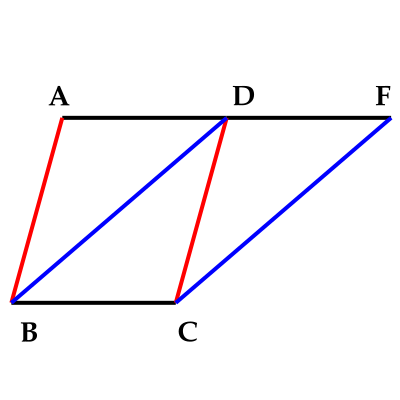(→응용) |
(→응용) |
||
| 42번째 줄: | 42번째 줄: | ||
| 유클리드 기하학 원론 제1권 법칙35 | | 유클리드 기하학 원론 제1권 법칙35 | ||
|} | |} | ||
{{인용문| Parallelograms on the same base (BC) and between the same parallels are equal. | |||
같은 밑변(BC)과 같은 평행선 사이의 평행사변형들(parallelograms)은 같습니다.|유클리드 기하학 원론 제1권 법칙35}} | |||
공통 밑변 <math>\overline{BC}</math>를 갖는 평행사변형 <math>ABCD, DBCF</math>의 변 <math>\overline{AD}, \overline{DF}</math>가 같은 점 <math>D</math>에서 끝나도록 하면 각 평행사변형은 삼각형 <math>BCD</math>의 두 배이다. 따라서 그들은 서로 동등하다. | 공통 밑변 <math>\overline{BC}</math>를 갖는 평행사변형 <math>ABCD, DBCF</math>의 변 <math>\overline{AD}, \overline{DF}</math>가 같은 점 <math>D</math>에서 끝나도록 하면 각 평행사변형은 삼각형 <math>BCD</math>의 두 배이다. 따라서 그들은 서로 동등하다. | ||
2022년 3월 12일 (토) 21:27 판
Parallelogram
정의
사각형 중, 두 쌍의 대변이 각각 평행한 사각형. 사다리꼴의 세부 분류이며, 사다리꼴과는 달리 학교에서 자세히 다루게 되는 도형이다.
필요충분조건
일단 평행사변형의 정의는 따로 있지만, 그 정의와 필요충분조건인 다른 조건들이 꽤 많다. 아래는 그 목록.
- 두 쌍의 대변의 길이가 같다.
- 두 쌍의 대각의 크기가 같다.
- 두 대각선이 서로를 이등분한다.
- 한 쌍의 대변이 평행하고, 그 길이가 같다.
증명
1. [math]\displaystyle{ \triangle{ABC}\cong\triangle{CDA} }[/math](SSS 합동)임을 쉽게 알 수 있다. 따라서 [math]\displaystyle{ \angle{CAB}=\angle{ACD} }[/math]이고, 이는 곧 [math]\displaystyle{ \overline{AB}\parallel\overline{CD} }[/math]를 의미한다 (엇각). 마찬가지로 [math]\displaystyle{ \triangle{ADB}\cong\triangle{CBD} }[/math](SSS 합동)이고, [math]\displaystyle{ \angle{ADB}=\angle{CBD} }[/math]이므로 [math]\displaystyle{ \overline{AD}\parallel\overline{BC} }[/math]이다 (엇각).
2. [math]\displaystyle{ \angle{A}=\angle{C}=\alpha,\,\angle{B}=\angle{D}=\beta }[/math]라 하자. 사각형의 내각의 합은 360도 이므로, [math]\displaystyle{ 2\alpha+2\beta=360^\circ,\,\alpha+\beta=180^\circ }[/math]이다. 이를 이용해 엇각을 보일 수 있고, 따라서 [math]\displaystyle{ \overline{AB}\parallel\overline{CD},\,\overline{AD}\parallel\overline{BC} }[/math]이다.
3. [math]\displaystyle{ \triangle{AEB}\cong\triangle{CED} }[/math](SAS 합동)이고, 따라서 [math]\displaystyle{ \angle{EAB}=\angle{ECD} }[/math]이므로 [math]\displaystyle{ \overline{AB}\parallel\overline{CD} }[/math]이다 (엇각). 마찬가지로 [math]\displaystyle{ \triangle{AED}\cong\triangle{CEB} }[/math]이고, 따라서 [math]\displaystyle{ \angle{EAD}=\angle{ECB} }[/math]이므로 [math]\displaystyle{ \overline{AD}\parallel\overline{BC} }[/math]이다 (엇각).
4. [math]\displaystyle{ \overline{AB}\parallel\overline{CD} }[/math]이므로 [math]\displaystyle{ \angle{EAB}=\angle{ECD},\,\angle{EBA}=\angle{EDC} }[/math]이다 (엇각). 따라서 [math]\displaystyle{ \triangle{EAB}\cong\triangle{ECD} }[/math](ASA 합동)이고, 3번 조건에 의해 증명하고자 하는 바가 증명되었다.
역의 증명
1. [math]\displaystyle{ \overline{AB}\parallel\overline{CD} }[/math]이므로 [math]\displaystyle{ \angle{CAB}=\angle{ACD} }[/math]. 또한, [math]\displaystyle{ \overline{AD}\parallel\overline{BC} }[/math]이므로 [math]\displaystyle{ \angle{ACB}\angle{CAD} }[/math]. 그리고 [math]\displaystyle{ \overline{AC} }[/math]공통. 따라서 [math]\displaystyle{ \triangle{ABC}\cong\triangle{CDA} }[/math](ASA 합동). 따라서 [math]\displaystyle{ \overline{AB}=\overline{CD},\,\overline{AD}=\overline{BC} }[/math].
2. [math]\displaystyle{ \overline{AB}\parallel\overline{CD} }[/math]이므로 [math]\displaystyle{ \angle{CAB}=\angle{ACD} }[/math]. [math]\displaystyle{ \overline{AD}\parallel\overline{BC} }[/math]이므로 [math]\displaystyle{ \angle{DAC}=\angle{BCA} }[/math]. 따라서 [math]\displaystyle{ \angle A=\angle C }[/math]. 마찬가지 방법으로 [math]\displaystyle{ \angle B=\angle D }[/math]를 증명할 수 있다.
3. 1번에 의해 [math]\displaystyle{ \overline{AB}=\overline{CD} }[/math]. 또한, [math]\displaystyle{ \overline{AB}\parallel\overline{CD} }[/math]이므로 [math]\displaystyle{ \angle{EAB}=\angle{ECD},\,\angle{EBA}=\angle{EDC} }[/math]. 따라서 [math]\displaystyle{ \triangle{EAB}\cong\triangle{ECD} }[/math] (ASA 합동). 그러므로 [math]\displaystyle{ \overline{EA}=\overline{EC},\,\overline{EB}=\overline{ED} }[/math]
4. 1번에 의해 증명이 완료되었다.
넓이
사다리꼴의 넓이는 직사각형과 마찬가지로 밑변[math]\displaystyle{ \times }[/math]높이인데, 이유는 간단하다. 튀어나온 부분을 툭 짤라서 반대편에 붙이면 직사각형이 되기 때문. 혹은 [math]\displaystyle{ \overline{AB}=a,\,\overline{BC}=b,\,\angle{A}=\theta }[/math]라 하면 삼각함수를 이용해 [math]\displaystyle{ 2\times\frac{1}{2}\times ab\sin\theta=ab\sin\theta }[/math]로 구할 수도 있다. 대각선의 길이를 이용할 수도 있는데, 두 대각선의 길이를 각각 [math]\displaystyle{ p,q }[/math]라 하고 교각을 [math]\displaystyle{ \theta }[/math]라 하면 [math]\displaystyle{ \frac{1}{2}pq\sin\theta }[/math]가 넓이가 된다. 이유는 두 대각선을 변으로 하는 평행사변형을 만들었을 때, 원 사각형의 넓이의 두배가 되기 때문.
응용

|
| 유클리드 기하학 원론 제1권 법칙35 |
“ Parallelograms on the same base (BC) and between the same parallels are equal.
같은 밑변(BC)과 같은 평행선 사이의 평행사변형들(parallelograms)은 같습니다.“ — 유클리드 기하학 원론 제1권 법칙35
공통 밑변 [math]\displaystyle{ \overline{BC} }[/math]를 갖는 평행사변형 [math]\displaystyle{ ABCD, DBCF }[/math]의 변 [math]\displaystyle{ \overline{AD}, \overline{DF} }[/math]가 같은 점 [math]\displaystyle{ D }[/math]에서 끝나도록 하면 각 평행사변형은 삼각형 [math]\displaystyle{ BCD }[/math]의 두 배이다. 따라서 그들은 서로 동등하다.
이러한 제1권35번 법칙(theorem)은 평행사변형의 정의 및 성질을 잘 보여줄뿐만아니라 이등분된 삼각형에서 평행사변형들의 변형된 모습이 일관된 크기를 유지한다는 사실을 증명해보여줌으로써 유클리드 기하학적인 피타고라스 정리(유클리드 기하학 원론 제1권 법칙47)를 증명해 보여준다.
관련 항목
- [참고](유클리드 기하학 원론,구텐베르크 프로젝트,John Casey 1885)http://www.gutenberg.org/files/21076/21076-pdf.pdf?session_id=9bfd9ef535a37ac859a6028f101fa4451e3226cc